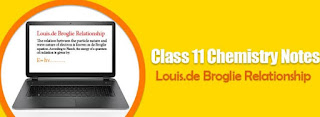Louis.de Broglie Relationship Class 11 Chemistry Notes
The de Broglie equation connects the wavelength of a moving particle to its momentum. The de Broglie wavelength,, is linked with a large particle and is connected to its momentum, p, via the Planck constant, h: To put it another way, matter acts similarly to waves. De Broglie claimed that electrons contain wave-like features, similar to how light has both wave-like and particle-like properties. Through the Planck constant, we can determine a relationship between the wavelength associated with an electron and its momentum by rearranging the momentum equation presented in the previous section.
The wavelength of a particle of mass m and velocity u, according to L. de Broglie, is given by the relation:
λ = h/mu
Derivation of de Broglie’s equation
The relation between the particle nature and wave nature of electron is known as the de Broglie equation. According to Planck, the energy of a quantum of radiation is given by:
E= hν…………………………….(1)
According to Einstein, mass and energy are related as:
E= mc2……………………………(2)
Where c is the velocity of light
Combining these two equations, we have:
hν = mc2
orhν/c = mc…………………………………….. (3)
Frequency, ν can be expressed in terms of wavelength, λ as,
ν = c/λ
or λ =c/ν
or 1/λ = ν/c
Substituting the value of ν/c in equation
or h/λ =mc
or λ= h/mc
This equation is applicable for a photon. According to L. de Broglie, the above equation can also be applied to the material by substituting the mass of the particle m and its velocity u in place of the velocity of light c. Thus wavelength λ of the material particle is given by:
λ= h/mu
The above equation is de Broglie equation and the wavelength is called as de Broglie wavelength.
or λ= h/p
where p is the momentum of the particle.
Thus, the significance of de Broglie equation lies in the fact that it relates the particle character to the wave character of matter.λ = h/mu

Comments
Post a Comment
Thank you we will contact ASAP.